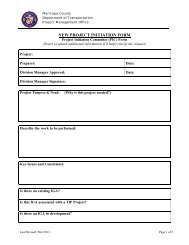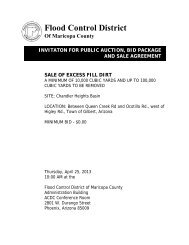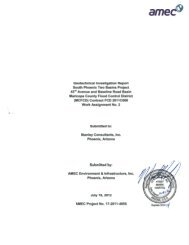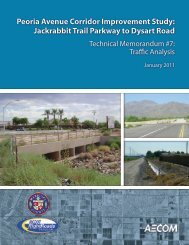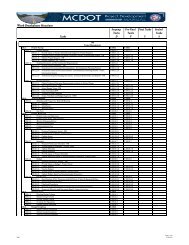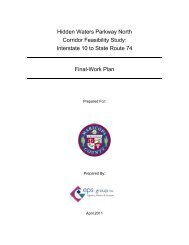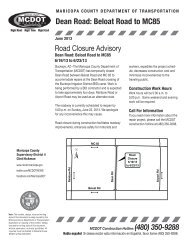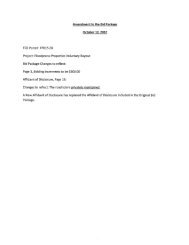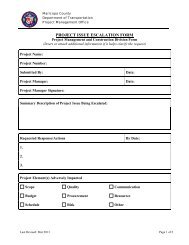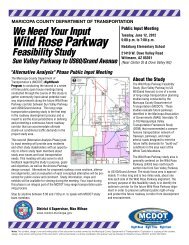Drainage Overview - Maricopa County Department of Transportation
Drainage Overview - Maricopa County Department of Transportation
Drainage Overview - Maricopa County Department of Transportation
You also want an ePaper? Increase the reach of your titles
YUMPU automatically turns print PDFs into web optimized ePapers that Google loves.
channel slopes at the base <strong>of</strong> the White Tank Mountains can result in high flow velocities<br />
with the energy to move significant volumes <strong>of</strong> sediment and debris during floods.<br />
The SVADMP analyzed several alternatives for mitigating the flood hazards <strong>of</strong> the alluvial<br />
fans including structural and non-structural strategies. The result <strong>of</strong> the alternatives<br />
evaluation process was to recommend large in-line detention basins at the apex <strong>of</strong> each<br />
alluvial fan together with downstream corridors protected by levees. The detention basins<br />
were designed to outlet 10 percent <strong>of</strong> the 100-year inflow volume from each alluvial fan.<br />
The corridors were designed to act as regional flood control trunk systems and were sized to<br />
include local drainage as well as sediment from adjacent watershed areas. Numerous drop<br />
structures would be constructed as part <strong>of</strong> the wash corridors. A conceptual cross-section <strong>of</strong><br />
the leveed corridor and the location <strong>of</strong> the recommended flood control improvements are<br />
included in Appendix TM3-07. The Deer Valley Parkway alignment will almost certainly<br />
cross the proposed leveed drainage corridor associated with alluvial fan #2. Similar to<br />
typical wash crossings, the final design <strong>of</strong> this crossing will need to accommodate the<br />
hydraulic design and sediment load anticipated within the corridor, including the effect <strong>of</strong><br />
contraction and expansion <strong>of</strong> flows at the structure.<br />
3.4.4 Scour and Sedimentation<br />
Transport and distribution <strong>of</strong> sediment within the study area are significantly impacted by<br />
the CAP canal according to the Wittmann Area <strong>Drainage</strong> Master Study Update (ADMSU)<br />
Geomorphic and Sedimentation Analysis Report (FCDMC, 2005). The CAP canal is<br />
located upstream <strong>of</strong> the eastern portion <strong>of</strong> the study area and traverses the western portion<br />
<strong>of</strong> the study area. Concrete drainage over-chutes convey storm run<strong>of</strong>f and sediment across<br />
the canal upstream <strong>of</strong> and within the study area. Typically, sediment is deposited upstream<br />
<strong>of</strong> the over-chutes and scour occurs downstream <strong>of</strong> the over-chutes. According to the<br />
Wittmann ADMSU Sedimentation Report, all <strong>of</strong> the areas upstream <strong>of</strong> the CAP canal<br />
within the 100-year floodplain should be considered to be depositional hazard areas.<br />
The report also identified several sedimentation problems that are common with roadways,<br />
including the following:<br />
� Undersized bridges or culverts can cause significant deposition to occur<br />
upstream <strong>of</strong> the roadway and erosion to occur downstream <strong>of</strong> the roadway;<br />
� Gathering numerous washes into a single wash to reduce bridge construction<br />
costs can disrupt existing drainage patterns and have significant impacts<br />
downstream; and<br />
� Trapping <strong>of</strong> debris can have a major impact on the ability <strong>of</strong> culverts and bridges<br />
to adequately convey run<strong>of</strong>f and sediment.<br />
Alluvial fans are built up from sediment that drops out <strong>of</strong> flood waters when flows start to<br />
spread out at the base <strong>of</strong> mountains. Therefore, excessive sedimentation can be expected in<br />
active alluvial fan areas.<br />
3.4.5 Lateral Erosion<br />
Bank erosion from flood events is another critical concern for potential Deer Valley<br />
Parkway infrastructure. Most <strong>of</strong> the soils in the study area are composed <strong>of</strong> sands and noncohesive<br />
materials that water can easily erode. Avulsions can readily occur where some<br />
091337137, 2011-018, TT005 <strong>Maricopa</strong> <strong>County</strong> <strong>Department</strong> <strong>of</strong> <strong>Transportation</strong><br />
Technical Memorandum 3 Deer Valley Parkway Feasibility Study<br />
<strong>Drainage</strong> <strong>Overview</strong> 15 April 2012





